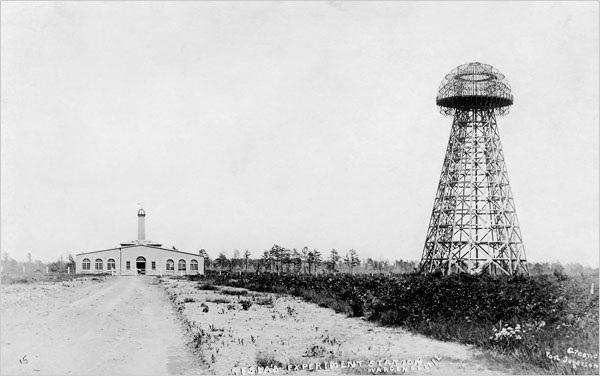Lately I’ve been spending a lot of time thinking about my career and where it’s going. I don’t want to give the impression that I have never thought about my career before, but now the thoughts are becoming constant.
Wireless Power Transfer was originally going to be the de facto standard for electricity during Nikola Tesla and Thomas Edison's time period. I mean who would put the time and money into creating an infrastructure; millions upon billions upon trillions of dollars in cost? Well, I guess it seems better to make money through a controlled medium like power lines than an uncontrolled medium like RF/Microwave Radiation. Oh Well.

Tesla's Failed Wireless Power Transfer Prototype
There are two main ways to perform wireless power transfer: RF/Microwave Radiation and Magnetic Coupling. What do these mean?
RF Radiation
With RF/Microwave radiation, we pick up emitted energy from the air from many different sources: TV Stations, Radio Towers, WiFi Routers, Satellite Signals, etc. We live in a wireless world and you would think there is plenty of energy right there in the air to be absorbed. You are right and wrong. Yes we have energy everywhere around us. In fact, your cell phone wouldn't work unless you had a connection. Nor would your wireless laptop. But what you may not realize is how little energy is reaching these devices. Let me explain.

A radiating device (i.e. Wireless Router, TV Power Station, etc) gives off a signal of enormous power (sometimes in the MegaWatts MW). This signal then passes through the air indefinitely until it is stopped by material that can absorb it (lead) or is undetectable in the noise of signal processing. The signal begins to degrade immediately as it enters the airspace. And depending on its frequency and strength can only realistically go so far. This is where Friis Equation comes in (Reference: https://en.wikipedia.org/wiki/Friis_transmission_equation).
The above is Friis equation in log format where Pr and Pt is power in dBm (Decibels per mW) and Gt and Gr are the transmitting and receiving antenna gains in dB (decibels). For a quick reference,
Power (dBm) => 30 dBm = 1 W, 40 dBm = 10W, 50 dBm = 100W, 90 dBm = 1MW, etc.Gain (dB) => 0 dB = 1, 10 dB = 10, 20 dB = 100, etc.
is the wavelength of the signal where
We can use v = 300E6 (speed of light in vacuum) and the frequency. Estimations but close enough for this discussion. Realistically you would use a phase velocity (v) that corresponds to air.
Assuming we are working with standard units (km, m/s, hz) R would be the distance between the antennas in meters.
Let's talk about an example,
A TV tower is emitting 1 MW of energy from its station to your house 3 km away. Let's assume the antenna gains are 1 (0 dB) and they are transmitting at a 60 MHz frequency. What would be the power received at your antenna?
Filling in the equation from above:
17.6 milliWatts (mW). That's it. From that 1MW of energy we will get 17 mW. That's not a lot. Cell phones in standby mode use more energy than that. That's not to say that multiple sources couldn't be used but you would be very lucky to get more than 100mW from all sources with very good antennas. This type of energy transfer is beneficial for distance, but not efficiency. It has been used before for sensor networks. Sensors are usually very low power (think RFID chips) and would be a great way to power very small power efficient devices long distance. But it won't power a car, charge your phone, or light your house any time soon. So now what?
Magnetic (Inductive) Coupling
Magnetic fields are inherent in any alternating current. Coils (due to resistance and material properties) induce fields when current changes direction. Transformers are a common use of inductive coupling and is used to transform power consistently into different voltages and currents for various circuits. Wireless Magnetic Coupling Power Transform is based on this same principle.
Due to the short range nature of magnetic fields, the two circuits that are interacting must be very close to each other (within 1 to 2 metres). The further out they get, the "looser" the coupling becomes. So these type of circuits must be close together. The circuits themselves must be resonant circuits in order to work at maximum efficiency. This means that the circuits resonate (lowest Q) at a very specific frequency. In practice, slightly off frequency resonant circuits give a higher efficiency. This is counter-intuitive but this is due to the natural losses and coupling effects. (Reference: https://en.wikipedia.org/wiki/Resonant_inductive_coupling)
There are a number of companies employing this type of circuit to create cell phone charging stations and in-room wireless power transfer modules. The circuit above shows basic principle. Although, I have only employed this once, it is very easy to build. It is a matter of setting up a power source with (low power, safe AC current) and building a resonant receiving circuit. I say easy, because the principle is easy. However, the equipment needed, is expensive.

Either way, this is an interesting concept. A company making this work is WiTricity (http://witricity.com/). There are others but this is the one I know about. I look forward to seeing where this is going and how far the physics can take us!
Til next time.
Related Posts
Check out our thoughts here.

There is always strong debate around databases and their role in development. Sometimes they are considered components, while others will consider them infrastructure. Is there a right answer? Let's discuss!

There is one, and only one, primary focus that any software developer acknowledge: the ability for software to be maintainable. Of course, correctness, functionality, and performance are all important, these will always be easier to address with maintainable software.

